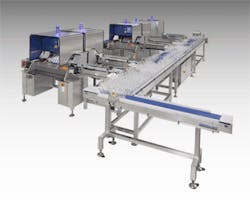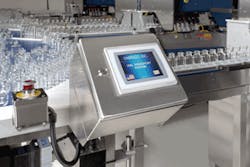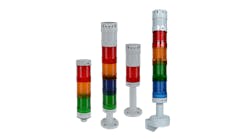The stack light is a staple of industrial machinery. The signal tower has been used for years to indicate machine state and process condition via color-coded indicator segments, according to IEC 60073: Basic and Safety Principles for Man-Machine Interface, Marking and Identification—Coding Principles for Indicators and Actuators.
Whether it’s controlled by PLC, DCS, PC, sensors or relays, the stack light has traditionally been a passive device. Typical color combinations of red, yellow, green, blue and white are actuated via discrete signals.
Over the years, stack lights have seen marked improvements such as protection for hazardous environments or washdown areas, but recent technology upgrades have turned them into the next evolutionary step along the industrial-equipment path.
Two such examples include Balluff’s SmartLight, programmed for custom indication on Dabrico’s inspection equipment, and Werma’s SmartMonitor, collecting and reporting production data on Conformis’ machinery.
Programmed for inspection
Figure 1: Dabrico specializes in building semi-automatic inspection equipment for handling and packaging, predominantly in the pharmaceutical industry.
Dabrico Automation Systems specializes in building semi-automatic inspection equipment for handling and packaging, predominantly in the pharmaceutical industry (Figure 1).
“We are an OEM. We build everything from the ground up,” explains Rick Ramirez, electrical controls engineer at Dabrico in Bourbonnais, Illinois. “A semi-automatic inspection machine still has some human input. There’s a central area where the operator sits. And there’s lighting with a top light, a bottom light and background lighting. The conveyor is servo-motor-driven.”
Two belt drives spin a sealed vial, or ampule, to kick up any particulate before it gets in the inspection area. “A servo is used for a low spin so the operator can get a full 360° view,” explains Ramirez. “That’s our bread and butter. We sell 25 to 40 of those inspection machines a year. We also build conveyor systems, and we build feeder tables to transport vials and ampules.”
Sometimes Dabrico includes a vision system for use those with its star wheels. “Sometimes they just want basic functionality,” explains Ramirez. “We use sensors for counting purposes to give me feedback for my servos. We use some ultrasonic sensors for vial detection to know when a conveyor table fills up. If they fill up, we can stop the feed. We use different types of sensor technology, depending on the application.”
Figure 2: All of the control components are Rockwell Automation Allen-Bradley—CompactLogix, and ControlLogix upon request, and PanelView for HMIs.
All of the control components are Rockwell Automation Allen-Bradley—CompactLogix, and ControlLogix upon request, and PanelView for HMIs (Figure 2). “We use quite a bit of analog I/O to control the speed on Integra dc motors. We use Animatics servos on the inspection machine to control the conveyor as well as the belt drive for the low-spin/high-spin functionality,” says Ramirez.
“Four or five months ago, our rep came in from Balluff,” he explains. “They were going over IO-Link sensors, and they had a display and a SmartLight. It grabbed my attention right away. She started explaining the functionality, and I was sold, once she explained everything you can do with it. We have our go-to stack light, but sometimes a customer wants a custom color. Sometimes a customer might want blue. Now I have something that covers all of my bases.”
One problem that all machine builders run into is that the stack light sticks up and needs to be removed for shipping. “We can take it off when we ship. The old stack had an I/O board that was a pain in the butt to rewire when it was removed to ship. This one is a quick-disconnect, Ethernet/IP program,” says Ramirez.
The first machines that included the Balluff SmartLight are going to India. “On this first system, I changed a lot of things because I had the stack light,” explains Ramirez. “Normally on my HMI I would have a certain color. If I had an e-stop, the message would be red. It makes it easier to see by a supervisor from across the room. You have more color options and the custom color options. I ended up using teal on the last system for when the system needed to be reset. I color-coded it with the HMI.”
The Balluff SmartLight allows Ramirez to program it for blue cascading to indicate a line-clear function. “The line is low, so slow down the conveyor,” he explains. “In full situation, yellow with a white running light means I’m paused but in a run state. The cascading effect that it does symbolizes when the machine is running. When the accumulation gets too low, it means I don’t have enough, and you want to stop or slow the conveyor. Even though it’s still running, there’s something happening that you need to be aware of. If there’s a full situation, it needs to slow, so it can catch up. If you see the cascading effect, something’s going on. There are three different functions—cascading, you can cascade any color; flashing for an alarm; and solid stack lights, which can be broken up into segments. I can just program it. It’s very simple to program.”
If there are any errors with the light, it can be set up in the program to display that to the operator. “There is virtual I/O,” explains Ramirez. “You can see when a light is triggered. It takes a little setup, but it’s not that bad. If there’s an error with the light, you can then get that operator feedback.”
Figure 3: The stack light’s unique look is a helpful selling point for Dabrico, as well.
Most customers comment that they’ve never seen anything like it before, says Ramirez (Figure 3). “We get a lot of positive feedback,” he says. “When it comes to the factory acceptance test, our customers love them. The PLC is in a cabinet, and the HMI is located in the hood where the operator sits at about head level in the middle of the machine. Once you plug it in, there’s no setup. It’s getting controlled by the PLC. You just plug it in, and it’s ready to go.”
Additive information
“Our claim to fame is that we do patient-specific knee implants,” says Len Newton, engineer at Conformis in Billerica, Massachusetts. Corformis’ intellectual property (IP) turns a computed-tomography (CT) scan into a CAD drawing. “Each implant we make is an exact duplicate of your knee,” he says. “We have several pieces of equipment, including CNC nodes and laser-centric 3D printers for cutting guides. The CNCs are used to make the tibial plateau that accepts the plastic insert that replaces the cartilage. We use 3D printing for that. We have 27 3D printers and 18 CNCs with four more that will come online.”
Stack lights are standard on the Fanuc Robodrills used for machining. About 18 months ago, Werma sales manager, Peter Gasparini, brought the idea of an intelligent stack-light network with data-gathering and –reporting capabilities to Conformis and presented how it works. “Previously, we weren’t using anything,” explains Newton. “We were tracking by paperwork—this operator did this much this day.” By the first quarter of 2017, the new system was operational. “Now we have monitors company-wide to track flows. You can just touch green and see it. You can stand at one end of the room and see which machines are operating and which are not just by the monitor.”
Werma’s SmartMonitor uses an intelligent wireless industrial network of signal towers to create an alternative for industrial manufacturing-development-engineering (MDE) systems looking for a way to collect data and optimize processes.
“The beauty of the Werma system is we use it for tracking uptime and for tracking maintenance time used,” explains Newton. “We have four lights with a blue light. On the CNCs, they have to be tight tolerance. When we reload the parts on the machine, there can be no expansion. We use the fourth light to track the warmup program. We installed a relay attached to the PLC terminals. We track the controlled stops. It’s tracking productive time.”
When the machine is running a part, the blue light is disengaged. “We’ve created an M code to engage and disengage the blue light,” explains Newton.
“On our group of CNC machines, we do poly inserts, which are just plastic,” says Newton. “They use air as a cooling agent. We were having trouble with our compressor volumes. In the interim, we used the Werma system to see how much time each machine was running. We could shut off certain groups of machines during the day, and that was a big savings. It probably saved us 80 cfm that we needed in other places. By looking at the scales and seeing which machines ran how long, we decided which machines we could shut off. We would never have been able to figure that out without it.”
Conformis not only gets a better idea of what the flow is, it can monitor the compressor savings. “By mapping the productivity of the machine, you could see the uptime and unproductive time on the machine during the day,” says Newton. “You can shut a machine down, for example, and save the use of two machines.”
In the poly cell, Conformis can’t use a liquid coolant, so it uses air from Kaeser Compressors through a Venturi fixture. “That’s a high volume of air to cool off the plastics and to cool off the cutting surface,” explains Newton. “With a 400-cfm compressor and 20 machines, our new system will have a Sigma Air Manager 4.0 system to ramp up and ramp down in preparation for your high-use times.”
Conformis’ management team primarily was interested in the SmartMonitor for tracking uptime and downtime. But Newton saw other opportunities.
“It’s a 24 V system, so we’re finding all kinds of fun ways to use it. We are looking now to integrate it in our clean rooms. If the signals can track raise of climb, we can set up an alarm if it starts to go out of spec. At a certain rate, we’ll know it’s a heating issue or some temperature issue. We’ll want to mount them in the controller. We have a clean line, and it will send us an alarm. It’s great technology. I think the software could use a little tweaking because I had to do some things with relays. If two lights come on at once, it doesn’t track it well in terms of runtime or usage.”
The data downloads through SQL database, explains Newton. “Then we download that via the Internet,” he says. “I know that they use a Boolean logic sequence, so we could set alarms to it. There are a dozen ways to do what I want it to do in the clean room. I like continuity across the whole system.”
Everything is PLC-driven at Conformis. “If you were going to try to monitor in another way, you’d have to alter the programming. The ease of operation with the 24-V input makes it so much easier,” says Newton.
Because Conformis is an FDA-regulated facility, it can’t change the programming. “We tied the relay into the appropriate bit on the terminal and are turning it on and turning it off with the M codes,” explains Newton. “The wiring is simple. In our CNC area, we run three shifts five days a week.” The additive-manufacturing process, selective laser sintering (SLS), runs 24/7.









